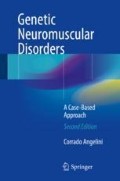Abstract
Peroneal muscular atrophy has been called Charcot-Marie-Tooth (CMT) disease. Several genetic entities pertain to this disorder, both with autosomal dominant and autosomal recessive or X-linked pattern of inheritance. Electrophysiological studies suggested that the slowing of nerve conduction velocities distinguishes patients with a hypertrophic demyelinating form (CMT type 1) from patients with a neuronal form (CMT type 2).
CMT1B, which constitutes about 6–10% of all CMT, is associated with point mutations in MPZ gene, encoding myelin protein zero (Table 91.1). Myelin protein zero is the most abundant protein of peripheral nervous system myelin and seems to be essential both for processing of the myelin membrane and for the maintenance of the compact structure of mature myelin.
In CMT1B, the nerve conduction velocity shows a bimodal curve, with some families having slow median motor NCV (mean, 16.5 m/s) and others having normal or near-normal NCV (mean, 44.3 m/s). The individuals in this latter “normal” NCV group tend to have lower CMAP, later age of onset, and more frequent hearing loss and pupillary abnormalities. These findings suggest the existence of two types of CMT1B: primarily demyelinating and primarily axonal. The two types probably reflect functional differences in the MPZ protein caused by different mutations in MPZ.
Individuals with slow NCVs tend to have demyelinating features on nerve biopsy, whereas those with normal NCVs have more axonal pathology with axonal sprouting. Onion bulb formation and excessive myelin folding and thickness may occur.
Access this chapter
Tax calculation will be finalised at checkout
Purchases are for personal use only
References
Hayasaka K, Himoro M, Sato W, Takada G, Uyemura K, Shimizu N, Bird TD, Conneally PM, Chance PF. Charcot-Marie-Tooth neuropathy type 1B is associated with mutations of the myelin P(0) gene. Nat Genet. 1993;5:31–4.
Schiavon F, Rampazzo A, Merlini L, Angelini C, Mostacciuolo ML. Mutations of the same sequence of the myelin P0 gene causing two different phenotypes. Hum Mutat. 1998;S1:S217–9.
Charcot JM, Marie P. Sur une forme particulaiere d’atrophie musculaire progressive souvent familiale debutant par les pied et les jambes et atteignant plus tard les mains. Rev Med. 1886;6:97–138.
Tooth H. The peroneal type of progressive muscular atrophy. London: Lewis HK; 1886.
Dyck PJ, Lambert EH. Lower motor primary sensory neuron disease with peroneal muscular atrophy: neurologic, genetic and electrophysiologic findings in hereditary polyneuropathies. Arch Neurol. 1968;18:603–18.
Author information
Authors and Affiliations
Rights and permissions
Copyright information
© 2018 Springer International Publishing Switzerland
About this chapter
Cite this chapter
Angelini, C. (2018). Charcot-Marie-Tooth Disease, Type 1B. In: Genetic Neuromuscular Disorders. Springer, Cham. https://doi.org/10.1007/978-3-319-56454-8_91
Download citation
DOI: https://doi.org/10.1007/978-3-319-56454-8_91
Published:
Publisher Name: Springer, Cham
Print ISBN: 978-3-319-56453-1
Online ISBN: 978-3-319-56454-8
eBook Packages: MedicineMedicine (R0)

